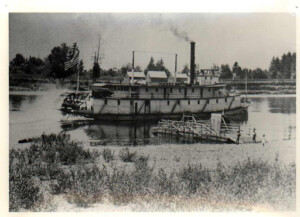Salem’s Steamboats

1910 c., Stern Wheel Riverboat proceeding down stream. Passing ferry at bank of river. Ferry crew watching riverboat., WHC Collections 0083.006.0017.025
For the first fifty years of Salem’s life, as it grew from frontier village to city, the Willamette River was its highway and steamboats carried the traffic. The obvious use of the steamboat was to bring in people and cargo, but as on any highway, there was not only commerce, but drama.
In 1861, when Salem was just beginning to be marked on maps, it was nearly washed away by flooded Willamette. The steamer Onward rescued forty persons at the mouth of Pringle Creek. Only four years later, commerce had gained an important foothold on the river as steamboats transported flour from the Willamette Flouring Mill at Front Street. The boat dock just north was always busy as inland farm crops were loaded for export. By 1890 the steamboats at the foot of Trade Street were graced by affectionate names such as Ramona, Gypsy, and Ruth.
In the last quarter of the nineteenth century, steamboats were enjoying the attention of Salem citizens as they took excursions to Albany and Corvallis. In 1885, a gingerbread-decorated City of Salem entertained riders with music from the local Masonic Band.
By the turn of the century, Salem was moving east, away from the river as the railroad supplied the transportation need of the farm co-ops and fruit processors. Sturdy, shallow draft sternwheelers, such as the Julius, served the Spaulding Logging Company as late as 1908. But by the time The Great War was won ten years later, the railway carried the commerce and the automobile was becoming the accepted way for families to travel for business and pleasure in the Capitol City.
In 1924, drifting ice caught and damaged the Relief from Portland at the foot of Court Street. It was a sign of the perilous times for commerce by water: the local Salem Navigation Company turned to trucks in mid-1930s. The higher costs of stevedores and heavy truck traffic in the valley during the Depression almost stopped river traffic.
Harvey Fox, a retired local businessman, remembers when, as a youngster selling newspapers from his corner at Court and Commercial, he would listen for the steamboat signal at three o’clock in the afternoon twice a week. It announced the Wednesday or Friday arrival of cargo from Portland. Harvey would rush down to the dock to sell his papers at 5 cents each. He also fondly recalls the delicious cinnamon bun he would purchase from the ship’s bakery.
Today an excursion stern-wheeler is the last vestige of what was once a vital link in Salem’s commercial life: steamboat traffic on the Willamette.
Researched and written by Virginia Green
This article originally appeared on the original Salem Online History site and has not been updated since 2006.







Leave A Comment